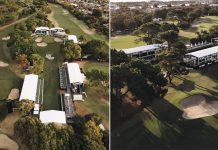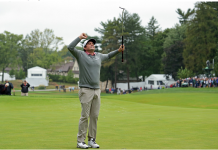
By 1928, the bulk of Donald Ross’s extensive body of design work was behind him. The Scottish transplant who had begun life at Royal Dornoch, apprenticed under Old Tom Morris in St. Andrews, and emigrated to the United States in 1899, certainly remained active building the odd new course here and there and remodeling courses he had designed 10 or 20 years before, but all of his very best designs (barring Seminole which opened in 1929) were already operating.

His exceptional achievements at Pinehurst (No. 2 in particular), Oakland Hills, Oak Hill, Inverness, Interlachen, Plainfield, Scioto, Old Elm, Essex County and dozens of other world-class courses had established Ross as perhaps the finest course architect of his day, (if not all-time). But when the 50-something – he was 55 when the course opened – began work on Aronimink Golf Club, his creative juices were still flowing and he considered this opportunity as good as any he’d ever been given.
A plaque on the first tee honors Ross and displays a telling quote on exactly how he felt about the place.
“I intended to make this my masterpiece,” the plaque says, “but not until today did I realize that I built better than I knew.” He uttered those words in 1948 – 20 years after the course had opened, indicating how busy he’d become in his later years, and, perhaps, how little time he was able to spend on site during construction.

The club began life in 1896 when members of the Belmont Cricket Club, keen on trying the Scottish game, cut a few holes in the ground at 52nd St. and Chester Ave. in what is now West Philadelphia. The golfers split from the cricketers and became the Belmont Golf Association, one of the founding clubs of the Golf Association of Philadelphia. The BGC incorporated as Aronimink Country Club (named for a chief of the Lenape Indian tribe) in 1900 and soon moved to a new site, half a mile west, after deeming its original nine holes unworthy. Future two-time US Open champion John McDermott caddied here as a youngster.
In 1913, they upped sticks again, moving two miles further west to Drexel Hill where AW Tillinghast built 18 holes. But Philadelphia kept gaining on them, so in 1926 – six years after becoming the Aronimink Golf Club, the members decided to leave the City of Brotherly Love altogether. They sold the Drexel Hill site for $1.2m and relocated 15 miles west to a 300-acre property in Newtown Square, about five miles from Merion GC, where they called upon Ross, rather than Tillinghast, to build the new course. Ross worked alongside longtime associate, and Aronimink member, J.B. McGovern.
Aerial photographs taken in 1929 by J. Victor Dallin, a former Royal Air Force pilot, who had formed the Dallin Aerial Survey Company five years previously, show the course possessed over 170 bunkers around the time it opened, though there is some doubt over who was actually responsible for them all.

In the photographs, the bunkers appear in clusters of three or four which wasn’t Ross’s typical style. Ron Prichard, a Ross expert who has restored dozens of the Scotsman’s courses, and who carried out an acclaimed restoration of Aronimink in the late 1990s, believes this indicates McGovern actually built the bunkers in Ross’s absence. Also worth noting, says Prichard, is that Ross’s course drawings show large, single bunkers rather than clusters. The club, however, maintains that Ross would sometimes make alterations to his original plan in the field and, in the case of Aronimink, he decided to break up the single bunkers into three or four.
Prichard’s restoration undid most, if not all, of the work Robert Trent Jones had performed in the early 1980s when he’d built his familiar runway tees and altered the character of the course tremendously (before Jones, Dick Wilson and Bill Gordon had done much to extinguish Ross’s creativity).
Believing there to have been about 75 bunkers in Ross’s original plan, Prichard left 75 bunkers. And it was this version that PGA Tour players faced at the 2010 and 2011 AT&T National – won by Justin Rose and Nick Watney respectively.
This week, players will see an entirely new Aronimink, at least something very much like the one shown in Dallin’s aerial photographs. In 2016, Gil Hanse was hired to complete a $4m renovation, complete with all 175 or so bunkers restored.
“We really studied the aerial photographs that the club had in their records,” Hanse told Philadelphia’s Main Line Today earlier this year. “The Dallin collection was an amazing resource. And with the help of our talented associate, Jaeger Kovich, and course superintendent John Gosselin, we were able to get the bunkers as close as possible to our understanding of the original as-built design.”
Hanse and his design partner Jim Wagner, also rebuilt tees creating the free-form shapes of the original course, and expanded greens to their original dimensions.
“The biggest difference, though, is the bunkers,” says Hanse. “That’s what the players and TV viewers will notice the most.”
Hanse’s Three Most Interesting Holes at Aronimink
Hole No. 5: Par 3, 178 yards ‘Mohawk’
“We actually shortened this hole by about 25 yards. It’s no more than a short-iron as its plays slightly downhill. But though it’s shorter it’s still a tough tee shot as we ramped up the security by re-establishing the green’s size and contours.”

Hole No. 11: Par 4, 408 yards ‘Kiowea’
“This will probably be the most talked-about hole. It’s visually pretty stunning with around 20 bunkers. It’s a beautiful arrangement, and the green is quite severe. It plays just over 400 yards, but it’s not an easy four.”
Hole No. 15: Par 4, 500 yards ‘Lenape’
“We expanded the green by about 15 paces at the back, and restored Ross’s bunker clusters. The green is fairly flat, one of the easier greens on the course, but it’s still a long and difficult par 4.”
Past Tournaments Held at Aronimink
1962 PGA Championship (Gary Player)
1977 US Amateur (John Fought)
1997 US Junior Amateur (Jason Allred)
2003 Senior PGA Championship (John Jacobs)
2010 AT&T National (Justin Rose)
2011 AT&T National (Nick Watney)
Future Events
2020 KPMG Women’s PGA Championship
2027 PGA Championship






































